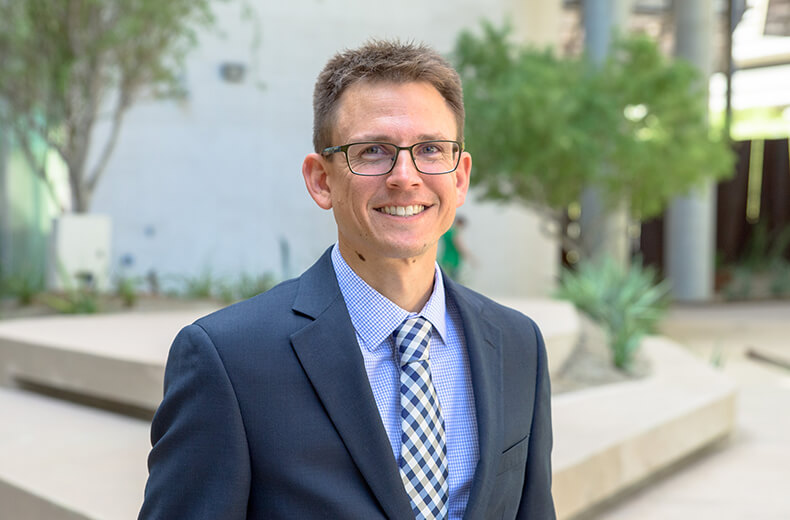
Enterprise Program Funds Research on Diagnosing Adverse Reactions to Heparin

Researchers are developing a way to better diagnose adverse reactions to heparin, a blood thinner used in almost half of all hospitalized patients, which could reduce the need for diagnostic tests, decrease costs and save lives.
Tyler Gallo, PharmD, an assistant professor in the Division of Clinical Data Analytics and Decision Support at the University of Arizona College of Medicine – Phoenix, is leading a project that will create and implement a clinical decision support tool to aid clinicians in understanding if a diagnostic workup for heparin-induced thrombocytopenia (HIT) is necessary. The goal of the project is to help reduce costs and risks to patients.
Heparin is a blood thinner given to many hospitalized patients to decrease the risk of blood clots after surgeries, dialysis or when patients are immobile. Platelets assist with blood clotting, and a low number of platelets in blood is called thrombocytopenia. Heparin-induced thrombocytopenia is a disorder in which heparin causes low blood platelets, but with paradoxical increased blood clotting, causing subsequent blood clots in arms and legs, heart attacks, strokes and other complications. Thrombocytopenia is common in hospitalized patients and has many causes, but few of those patients have HIT.
“HIT is often suspected or diagnosed in cases when the condition is not actually present, because of inappropriate ordering of diagnostic testing,” said Dr. Gallo, who is also an assistant professor at the University of Arizona College of Pharmacy. “Falsely suspecting the condition leads to increased costs for unnecessary testing and may increase the risk of severe bleeding in patients who receive alternative therapy to heparin.”
The clinical decision support tool Dr. Gallo is designing will help in two scenarios: when physicians fail to order diagnostic testing in patients who potentially have HIT and suspecting HIT in patients with a low likelihood of the condition.
“The problem with testing for HIT in patients who have a very low risk includes the risk of false positives and following guideline recommendations to initiate a different anticoagulant in patients suspected of HIT,” Dr. Gallo said. “These alternative anticoagulants are more expensive and often have higher bleeding risks. Therefore, if no diagnostic workup is necessary, the clinical decision support tool we are developing has the potential to decrease costs, and more importantly, decrease the risks of bleeding from using alternative therapies.”
HIT is a rare event, occurring in about 0.2 percent of heparin-exposed patients. However, about 30 percent of all hospitalized patients receive heparin products, resulting in an estimated 500 cases of HIT annually in Arizona. The first diagnostic test that is ordered to evaluate for HIT takes about 1-2 days to return results and has a high false positive rate. The confirmatory test takes about five days to perform, is expensive and requires a specialty lab to analyze.
“HIT is an important patient safety issue because it can lead to severe, and possibly fatal events, but over-diagnosis also poses risk,” said Dr. Gallo, who has studied HIT in the Banner Health system for more than three years.
In January, Dr. Gallo received $110,510 from the Banner Enterprise Risk Management Program to allow investigators to develop and implement HIT clinical decision support. Dr. Gallo is working on the project with Steven Curry, MD; Robert Raschke, MD, and Will Heise, MD, who are all faculty in the Division of Clinical Data Analytics and Decision Support.
“Our next step is to work with programmers at Banner to develop the HIT advisory,” Dr. Gallo said, “which will help clinicians determine if a diagnostic workup for HIT is necessary. We have created a team with University of Arizona and Banner Health personnel who will work collaboratively throughout the process and ensure appropriate oversight. After the clinical decision support has been implemented, we will study the impact of the advisory on provider behavior and patient outcomes.”
About the College
Founded in 2007, the University of Arizona College of Medicine – Phoenix inspires and trains exemplary physicians, scientists and leaders to advance its core missions in education, research, clinical care and service to communities across Arizona. The college’s strength lies in our collaborations and partnerships with clinical affiliates, community organizations and industry sponsors. With our primary affiliate, Banner Health, we are recognized as the premier academic medical center in Phoenix. As an anchor institution of the Phoenix Bioscience Core, the college is home to signature research programs in neurosciences, cardiopulmonary diseases, immunology, informatics and metabolism. These focus areas uniquely position us to drive biomedical research and bolster economic development in the region.
As an urban institution with strong roots in rural and tribal health, the college has graduated more than 1,000 physicians and matriculates 130 students each year. Greater than 60% of matriculating students are from Arizona and many continue training at our GME sponsored residency programs, ultimately pursuing local academic and community-based opportunities. While our traditional four-year program continues to thrive, we will launch our recently approved accelerated three-year medical student curriculum with exclusive focus on primary care. This program is designed to further enhance workforce retention needs across Arizona.
The college has embarked on our strategic plan for 2025 to 2030. Learn more.